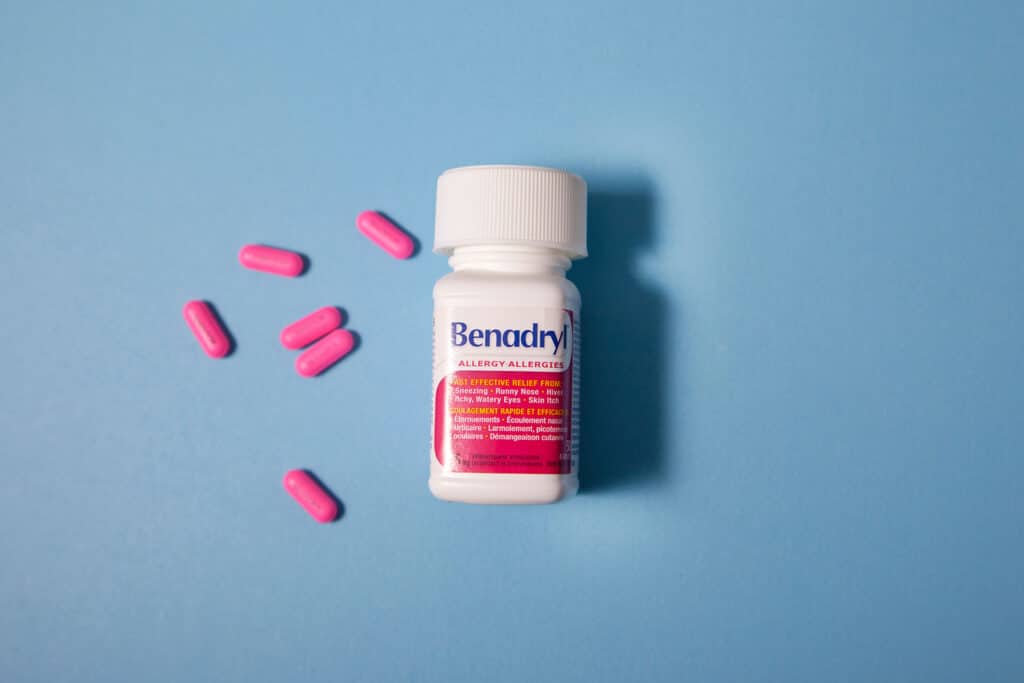Available since 1946, surveys show that Benadryl is the most widely recommended medication for children in recent years. However, understanding how long Benadryl remains in the body is crucial to determine how it can affect your day-to-day activities. This article takes an in-depth look at how long the drug stays in your system and the factors that influence its duration.
Table of Contents
What Is Benadryl?
Although you may recognize Benadryl as an over-the-counter medication found in your pharmaceutical aisle, it’s actually the brand name for diphenhydramine, an antihistamine medication. Many people take Benadryl to help alleviate their allergy symptoms.

Treatment
Some common uses of Benadryl include treatment for:
- Seasonal and perennial allergy symptoms, such as runny nose and sneezing
- Colds
- Hay fever
- Itchy skin
- Itching due to minor scrapes and cuts
- Rashes
Due to Benadryl’s sedative properties, it can also be used as a sleep aid. Benadryl comes in different forms: as a liquid, liquid gel, or as a chewable tablet.
Mechanism of Action
When you have an allergic reaction, such as a rash due to poison ivy, your body releases histamine. This chemical typically triggers allergic symptoms, such as sneezing, itching, watery eyes, or a runny nose. Benadryl’s active ingredient diphenhydramine, blocks these histamine receptors, effectively alleviating your allergy symptoms.
Pharmacokinetics of Benadryl
The pharmacokinetics of Benadryl happen in four steps.
Absorption
Once you ingest Benadryl in either liquid or tablet form, it is absorbed into the body relatively quickly. The active ingredient, diphenhydramine, travels to your stomach and is then absorbed into your bloodstream through your body’s gastrointestinal tract. This absorption process takes about 30 minutes.
Distribution
After diphenhydramine is absorbed into your bloodstream, it is then distributed throughout your body. Diphenhydramine is especially potent because of its ability to cross the blood-brain barrier and block histamine receptors. The blood-brain barrier is a shield that blocks the brain’s blood vessels from the rest of your body’s circulatory system. This ability to cross the blood-brain barrier is what contributes to the sedative effects of diphenhydramine.
Metabolism
Once Benadryl blocks your histamine receptors, the next step goes into effect: metabolism. Cytochrome P450 enzymes in the liver break down diphenhydramine into metabolites that are easier for the body to eliminate. This helps prevent diphenhydramine from staying in the body long-term and causing unwanted side effects.
Excretion
The final step is excretion. Now that diphenhydramine metabolites are in a form that’s easy to eliminate, the kidneys eliminate the rest of the diphenhydramine through urine. This step ensures the last bits of Benadryl are cleared out from your body.

Half-Life of Benadryl
The half-life of a drug is the time it takes for the concentration of that drug to decrease by half in your bloodstream. For example, if the half-life of a drug is six hours, only half of the initial concentration of the drug will remain in your bloodstream after six hours. This is important to know because the half-life determines how long you need to wait before taking another dose of the drug.
Typical Half-Life of Benadryl
The half-life of Benadryl is approximately four to nine hours, with the duration of effects lasting anywhere between 4-6 hours. Both ranges are based on age, weight, and metabolism. For children, the half-life is approximately four hours; and for adults, the half-life is approximately nine hours.
What this means is that the effects of Benadryl will typically last for about 9 hours in an adult before the adult needs to take another dose. So, if you take the recommended dose of Benadryl in the morning, you may need to take another dose in the afternoon. Benadryl has sedative effects, so it’s important to take this into account when taking a dose.
Understanding the half-life of Benadryl can better help you manage your symptoms while ensuring you don’t take too much of the medication.
Duration of Effects vs. Presence in the System
While the effects of Benadryl typically last anywhere between 4-6 hours, the drug may remain in the system longer. If the drug has a half-life of 9 hours for the average adult, then it would a minimum of 18 hours for the body to completely eliminate any traces of it.
This means that while your allergy symptoms may have returned after 6 hours, the first dose of Benadryl is still in your system. This remaining presence is why it’s important to follow the recommended dosage guidelines.
Moreover, diphenhydramine can be detected up to 24 hours after your last dose. However, this time can vary as your metabolism plays a large part in how fast your body can eliminate a drug.
Your liver plays an important role in how fast your body metabolizes diphenhydramine. Moreover, your kidneys’ efficiency at excreting the metabolites from your urine is important, too.

Factors Affecting How Long Benadryl Stays in Your System
Although Benadryl typically stays in your system for 24 hours, this window can be influenced by several factors.
Age
As people age, their metabolism slows down, specifically how their liver breaks down substances and how their kidneys filter out metabolites. This translates to older adults having slower clearance, which means Benadryl may stay in the system of older adults longer than it would for children or younger adults. Because age is an important factor, it’s crucial for older adults to pay attention to the recommended dosage to avoid complications.
Body Weight
Body weight can also influence how long a drug stays in your system. A higher body mass means the tissues can store drugs longer, which can then lead to a slower release into the bloodstream and a longer duration before the drug is entirely eliminated. On the other side of the spectrum, people with a lower body weight can eliminate the drug faster.
Metabolic Rate
People with a faster metabolism rate can break down diphenhydramine and excrete it faster. On the other hand, the drug will linger in the bodies of those with a slower metabolism rate. As a result, they will feel the effects of Benadryl for a longer time. The metabolism rate is influenced by genetics, age, and health.
Liver and Kidney Function
Since the liver is responsible for breaking down diphenhydramine and the kidney is responsible for eliminating it, impaired liver or kidney function can significantly prolong the presence of Benadryl in your system. In both cases, you may feel lingering side effects and may have to alter dosage amounts as a result.
Frequency and Dosage
Taking Benadryl frequently or in higher doses can lead to the drug accumulating in your system. As a result, detection times may extend past the 24-hour normal window. To avoid an unhealthy buildup of the drug, ensure you follow the recommended dosage and guidelines.

Detection of Benadryl in Drug Tests
There are different drug tests that can detect the amount of diphenhydramine in your body.
- Urine Test: This is the most common type of drug test as it is cost-effective and easy to administer. Urine tests can be used to detect diphenhydramine for 24-48 hours after use.
- Blood Test: Although blood tests are less effective than urine tests for diphenhydramine, they can still be used to test for the presence of diphenhydramine up to 12 hours after use.
- Hair Test: Hair tests can detect the presence of diphenhydramine up to several weeks or even three months after use, but this is not commonly used. Hair tests are typically used for general substance use.
Implications for Drug Testing
Most standard drug tests don’t test for Benadryl. However, it’s wise to let the drug testers know if you have taken Benadryl to avoid false positives for substances like methadone. Diphenhydramine may also give a false positive for PCP, which is a hallucinogenic.
Safety Considerations
For the most part, Benadryl is a harmless medication that helps many people suffering from allergy symptoms. However, there are some potential side effects to be aware of.
- Drowsiness
- Dizziness
- Constipation
- Dry mouth
- Upset stomach
- Blurred vision
Benadryl may also interact with other medications and drugs, such as topical antihistamines, cough relievers that contain codeine, muscle relaxants, and sleep aids. In addition, Benadryl interacts with alcohol and marijuana by intensifying its sedative effects.
Benadryl’s sedative effects can be dangerous if you exceed the recommended dosage as they can result in extreme drowsiness and confusion. These side effects can also be deadly if you mix Benadryl with other substances, such as opioids or alcohol.
If you are taking any medications or you have pre-existing conditions, consult with a healthcare provider before using Benadryl.

Allure Detox
Benadryl is an over-the-counter medication that helps many people alleviate their allergy and cold symptoms. And while it typically stays in your system for about 24 hours, this timeline can change depending on various factors, such as your age, body weight, metabolism rate, and the dosage amount.
It’s important to use Benadryl responsibly and consult with healthcare professionals if you have concerns about using it.
To learn more about the effects of Benadryl on your body, contact our team at Allure Detox. We are the premier drug and alcohol detox center in West Palm Beach, Florida.
Published on: 2024-08-08
Updated on: 2025-06-05



